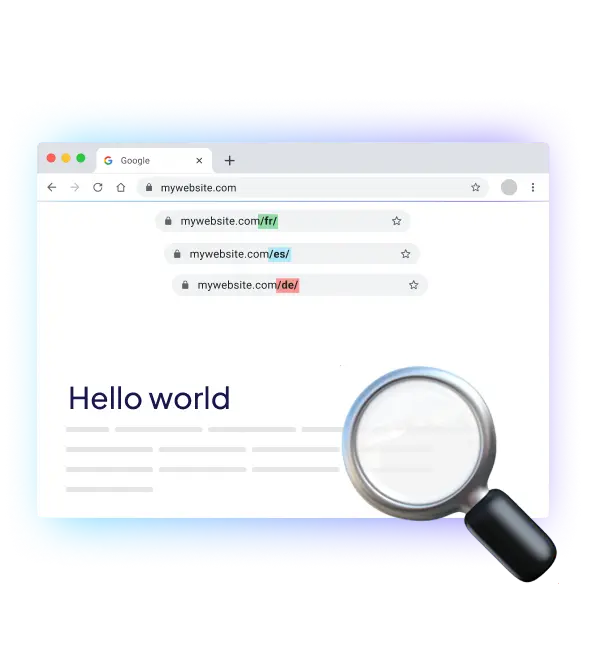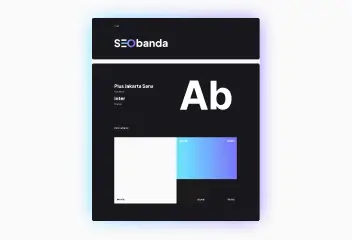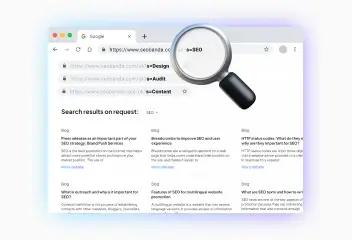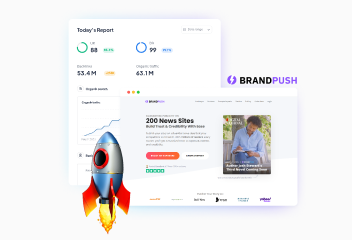Features of SEO for multilingual website promotion
A multilingual website is a website that has several language versions. It provides access to information to users from different parts of the world. The main goal of a multilingual website is to make it understandable and convenient for the widest possible audience.



Key points in the promotion of a multilingual website
Promotion of a multilingual website has some peculiarities that require certain strategies and approaches. Let’s take a look at the key points for SEO promotion of multilingual websites:
- Domains and subdomains:
- Use domains with a country code, for example, “google.de” for Germany or “google.fr” for France. This shows search engines that you are targeting a specific geographic market.
- Use subdomains for each language “de.example.com” or “fr.example.com”. This makes it easier to manage and points to separate language versions of the site.
- Subdirectories are also used for each language version separately, but look like “example.com/de/” or “example.com/fr/”. This allows you to maintain the strength of the main domain.
- hreflang attributes:
- The correct use of hreflang tags helps search engines identify the language and regional version of a page, preventing duplicate content and improving geographic targeting.
- High-quality translation:
- Professional translators should be used to make an accurate and understandable translation of the website, taking into account the cultural nuances of the country or people and the context.
- Localization:
- Localize the content taking into account local customs, cultural peculiarities, legal regulations, currencies, and units of measurement. For example, a unique design was created on the Arabic-language version of SEObanda’s website, taking into account the fact that the Arabic language is spelled from right to left.
- Local keyword research:
- Analyze and study the keywords in each target region to identify the correct wording used in that particular area and further optimize the site for such queries.
- Metadata optimization:
- Adapt titles, descriptions, and keywords for each language version of your site. Include local keywords to increase relevance and visibility, as well as attract users’ attention to your site.
- Local content marketing:
- Create locally relevant content that meets the interests and needs of users in each region. Use local topics and case studies to attract an interested audience.
- Link building:
- Get backlinks from reputable local sources to increase the authority of each language version of your site. If your website is linked to by local resources, Google takes these signals into account and boosts it in that particular area.
In fact, SEO promotion of a multilingual website is a very complex process that consists of a large number of factors. But does it make sense? Let’s take a look at the advantages and disadvantages of a multilingual website and draw some conclusions.


Advantages of a multilingual website
- Expanding the audience: the most obvious advantage of a multilingual website is a wider audience reach, because you can attract traffic to your resource from anywhere in the world. This allows you to expand your potential audience and increase brand awareness.
- Improving user experience: providing content in a user’s native language improves their experience and can lead to increased user engagement and loyalty.
- Increased conversions: Localized content is often perceived by users as more credible and relevant. This allows you to increase conversions (purchases, subscriptions, or feedback forms).
- More organic traffic and higher rankings: Proper optimization and promotion of a multilingual website can improve its visibility in search engines in different countries and attract more organic traffic. Google will notice that your site is in demand in different countries and will promote it to higher positions.
- Strengthening the brand: shows that the company is international and cares about its customers in different countries, which helps to strengthen the brand on a global level.

Increase visibility
for your business: SEO solution for growth!


Disadvantages of a multilingual website
- Costs of creation and maintenance: Creating content in different language versions requires additional resources, including the costs of website translation, localization, and maintenance.
- Complexity of management: A multilingual website requires careful management to avoid duplication of content, regularly update language versions, and prevent other problems that may arise due to constant changes in algorithms.
- Difficulty of implementation: search engine optimization becomes more complicated due to the need to use hreflang tags, avoid duplicate content, and ensure proper indexing.
- Potential technical issues: Different language versions can cause technical problems such as incorrect character mapping, encoding issues, or language switching failures.
- Cultural nuances: The biggest challenge with a multilingual website is the requirement for a deep understanding of the culture of a particular country. If users notice that you have tried to translate the text using a regular translator, it will cause a negative emotion rather than a pleasant admiration and trust. In this case, the person sees that you didn’t bother to translate it and translated it haphazardly. But when the translation of a website is of high quality, the user immediately pays attention to it and feels good, because they have been thought about and taken care of. For native speakers, it is immediately obvious whether the text was translated by a human or a robot.

Increase visibility
for your business: SEO solution for growth!


Common mistakes when setting up multilingualism



When setting up a multilingual website, there are many mistakes that can negatively affect its promotion in search engines. Below are the most common mistakes to avoid:
- Absence or incorrect use of hreflang
- The mistake is not using hreflang tags or including them in the site code, but doing so incorrectly. This can lead to duplicate content and confusion in search engines.
- Solution: seek professional advice and set up the tags correctly for each language version of the site so that search engines understand which version of the site corresponds to which region and language.
- Incorrect URL structure
- Error: using the same URL for several language versions or lack of a clear structure.
- Solution: use subdirectories, subdomains, or separate domains for each language version. This is also for better understanding by search engines and to prevent confusion.
- Automatic translation
- Error: Using automatic translators (for example, Google Translate) to create language versions of content. This can lead to incorrect translations and lower quality content.
- Solution: Find professional translators to create high-quality and correct content for each language version.
- Lack of content localization
- Mistake: translation of the text without taking into account cultural and regional peculiarities.
- Solution: Localize the content, including the adaptation of images, date and time formats, currencies, and units of measurement.
- Incorrectly configured language switches
- Error: using language switches that do not work correctly or redirect users to the wrong pages. This is a fairly common problem, as it requires careful work and is quite time-consuming.
- Solution: Make sure that the language switches are correctly configured and redirect users to the appropriate language versions of the pages.
- Duplicate content
- Error: Creating multiple language versions without using hreflang and canonical tags properly can lead to duplicate content.
- Solution: correctly configure hreflang and canonical tags for proper indexing and avoid duplication.
- Lack of metadata optimization for each language version
- Error: using the same metadata (title, description, and H1) for all (or several) language versions.
- Solution: optimize meta tags for each language version separately, using local keywords and making them completely unique.
- Ignoring mobile adaptation
- Mistake: Not having a responsive design for each language version. This can significantly worsen the behavioral factors and users’ opinions of your website.
- Solution: set up mobile optimization for each language version and make sure your website is easy to use on phones and tablets.
- Lack of analytics for individual language versions
- Mistake: lack of separate tracking for each language version. This makes it difficult to analyze the effectiveness of individual GEOs, which is very important in SEO.
- Solution: Use analytical tools such as Google Analytics to track the performance of each language version of your website.
- Neglecting local link building
- Mistake: lack of a link building strategy for each region. Obtaining links from local sources can significantly improve your website’s position in a particular country and achieve better results.
- Solution: create link building strategies for each region, get backlinks from local authoritative sources, and enjoy the results.


Conclusion
Proper optimization of a multilingual website requires attention to many details, but it is worth it because it brings results and allows you to promote your website to the whole world reaching new heights. If you want your brand to be recognized around the world, a multilingual website is your solution. Contact SEObanda and get high-quality services for the promotion of a multilingual website.
You may also like it

Brand identity: The key to brand recognition and SEO success
Every product has its own unique feature that sets it apart from other brands. It could be a special font, a unique mascot, or an interesting logo with the right...

What is a dynamic URL and its impact on SEO
A dynamic URL (Uniform Resource Locator) is a web address that changes depending on the user's request or specific parameters. It differs from a static

Press releases as an important part of your SEO strategy: Brand Push Services
SEO is the best promotion on the Internet that helps attract more potential clients and improve your market position. The use of press releases is an important SEO...












